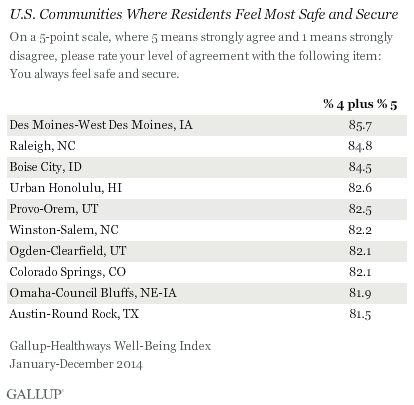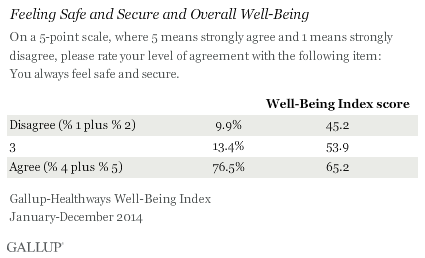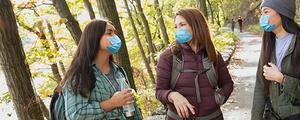Story Highlights
- Fresno, California, residents least likely to feel safe and secure
- Residents of Raleigh, N.C., Boise City, Idaho, most likely to feel safe
WASHINGTON, D.C. -- Less than 64% of adults living in each of three California communities -- Fresno, Stockton-Lodi and Bakersfield -- agree they always feel safe and secure, making these residents the least likely to feel safe among the 100 most populous U.S. metropolitan areas.

California is not the only state with multiple communities among the lowest 10 in reports of safety and security. Two Ohio metropolitan areas appear on the list: Toledo and the Youngstown-Warren-Boardman community, which straddles the Ohio-Pennsylvania border. In Florida, two communities rank ninth and tenth, respectively: Lakeland-Winter Haven and Deltona-Daytona Beach-Ormond Beach.
The 10 communities where residents are least likely to agree they feel safe are rounded out by fourth-ranked Memphis, Tennessee -- which also includes areas in Mississippi and Arkansas -- seventh-ranked Las Vegas, Nevada, and eighth-ranked New Orleans, Louisiana.
These findings are based on data collected throughout 2014 as part of the Gallup-Healthways Well-Being Index. Nationally, more than three in four Americans (76.5%) responded with a 4 or 5 rating on a 5-point scale. A 5 rating indicates respondents strongly agreed that they always feel safe and secure, and 1 rating means they strongly disagreed. Among the bottom 10, less than 70% of residents in these areas agreed they felt safe, whereas in the 10 communities where residents felt safest, at least 81.5% of residents agreed they felt this way.
Des Moines, Iowa, Residents Most Likely to Feel Safe and Secure
Residents of Des Moines, Iowa, top the list where residents feel safest, with 85.7% agreeing that they always feel safe and secure, inching out Raleigh, North Carolina, at 84.8%, and Boise City, Idaho, at 84.5%.
The communities topping the list where residents feel safest are diverse -- spanning from central Texas to Hawaii -- and vary in population. The largest metro area in the top 10 is Austin, Texas, with a population of nearly 2 million, while Des Moines, Iowa, is the smallest, with nearly 600,000 residents.

Three states account for more than half of the top 10 communities ranked on residents' sense of security. North Carolina and Utah each have two communities in the top 10 for perceived safety, and Iowa contributes two when including Omaha-Council Bluffs, a metro area Iowa shares with Nebraska.
Also among the metro areas where people reported feeling safest were Urban Honolulu, Hawaii; Colorado Springs, Colorado; and Austin-Round Rock, Texas.
Individuals Who Feel Safe and Secure Have Higher Well-Being
The Gallup-Healthways Well-Being Index score comprises metrics affecting overall well-being and each of the five essential elements of well-being: purpose, social, financial, community and physical. Americans' perceptions of feeling safe and secure strongly relate to their overall well-being. Twenty percentage points separate the Well-Being Index scores of those who agree they feel safe and secure (65.2%) and those who disagree (45.2%). Those who neither agree nor disagree have a Well-Being Index score in the middle, at 53.9%.
While three-quarters of Americans agreed they feel safe and secure in 2014, about one in 10 (9.9%) disagreed.

While there is a strong relationship between overall well-being and perceived safety, shared influencing factors could be shaping both. Someone with high financial well-being, for instance, could afford to live in a community with greater security. And people with high social well-being might have larger social networks, making them feel safer.
The survey item does not specify that respondents should respond in what ways they feel safe and secure. Most likely they are thinking about physical safety, especially related to crime. But if communities focus on improving general safety -- perhaps by increasing police forces or establishing neighborhood watch programs -- taking such measures could increase overall well-being. Residents who are less concerned about their safety might be more likely to focus on other areas of their well-being. Those who have a safe place to walk or run, for example, can focus more on their physical well-being. And those who feel safe in their neighborhood are more likely to engage with fellow members of their community.
Bottom Line
The degree to which residents feel safe in a given area has a tremendous effect on a community, including its propensity for economic growth and development. Neighborhoods that residents perceive as being "unsafe," for example, are less likely to attract businesses. At the individual level, though, perception of personal safety could have affect individuals' overall well-being and the way they live their lives. Chronic fear and anxiety that could come from feeling unsafe in a community could negatively influence residents' physical and mental health.
It is no coincidence, then, that most of the communities where residents feel least safe also rank at or near bottom of the Well-Being Index, while many of the communities where citizens feel safest rank at top of the index spectrum.
Survey Methods
Results are based on telephone interviews conducted as part of the Gallup-Healthways Well-Being Index survey Jan. 2-Dec. 29, 2014, with a random sample of 176,702 adults, aged 18 and older, living in metropolitan areas in the 50 U.S. states and the District of Columbia, selected using random-digit-dial sampling. Unlike previous years, only the 100 most populous metros -- as determined by the U.S. Census Bureau -- were reported in 2014. A second requirement is that at least 300 cases are required per metro area for reporting. As such, McAllen-Edinburg-Mission, Texas, and Durham-Chapel Hill, North Carolina, were both excluded from reporting because of insufficient sample size. These were replaced by the 102nd-largest metropolitan statistical area (MSA) in the U.S.: Lancaster, Pennsylvania.
The "communities" referenced in this article are based on MSAs as defined by the U.S. Office of Management and Budget. In many cases, more than one city is included in the same MSA. The San Jose, California, MSA, for example, also includes the smaller nearby cities of Sunnyvale and Santa Clara in addition to San Jose. Each respondent is attributed to his or her MSA based on self-reports of his or her ZIP code.
Maximum margins of error for the Well-Being Index and the element scores vary according to MSA size, ranging from less than 1 point for the largest cities represented to around ±1.5 points for many of the smallest cities.
All reported margins of sampling error include computed design effects for weighting.
Each sample of national adults includes a minimum quota of 50% cellphone respondents and 50% landline respondents, with additional minimum quotas by time zone within region. Landline and cellular telephone numbers are selected using random-digit-dial methods.
Learn more about how the Gallup-Healthways Well-Being Index works.

